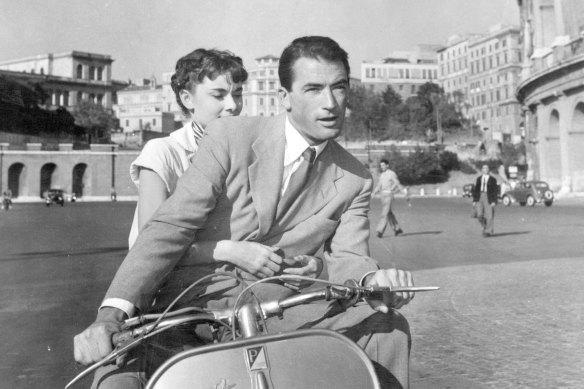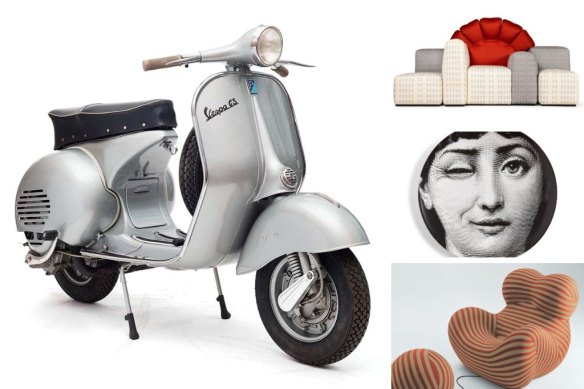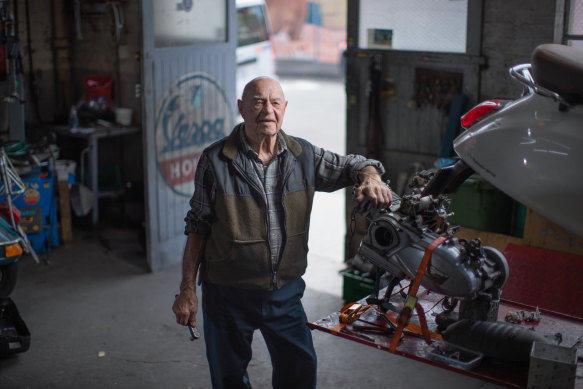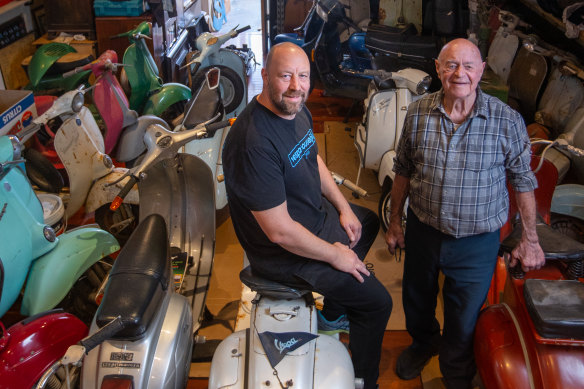
Alessi. Bialetti. Gaggia. Fiat. Fornasetti. Olivetti. Vespa. You don’t need to be a design buff to recognise the names. Such is the global success of Italian design. Children of the ’70s who regularly flopped into a bean bag may be surprised to learn that it, too, was an Italian invention, originally called “Sacco”, or sack. Developed by Piero Gatti, Cesare Paolini and Franco Teodoro for Zanotta, the 1968 Sacco was inspired by the humble mattresses of peasants, made from coarse fabric and filled with straw or dry leaves.
The Sacco, however, was filled with polystyrene beads and in 1969 the Australian furniture company Danish De Luxe rebadged it the “Bean Bag” and it took off in Australian homes. This is just one of many fascinating stories being told as part of the Molto Bello exhibition of modern Italian design at the Heide Museum of Modern Art.
Featuring more than 180 objects – from coffee-makers to cars, typewriters to table lamps, room dividers to radios, carpets to clocks, bowls to bookcases – the exhibition focuses on the far-reaching influence of Italian design.
While the spotlight is on furniture and household items – including about 20 variations of that Italian essential, the caffettiera (coffee-maker) – the show also features a 1957 Fiat Nuova 500, and a 1960 Vespa GS 150, aptly displayed before a clip from the 1953 film Roman Holiday, in which Audrey Hepburn, playing a runaway princess, rides through the eternal city on a Vespa with co-star Gregory Peck.

Audrey Hepburn and Gregory Peck in Roman Holiday.Credit: Paramount Pictures
For Heide head curator Kendrah Morgan and associate curator Laura Lantieri, the exhibition was a way of engaging with the local Bulleen community and its Italian roots, and tapping into the resurging interest in Italian design.
“We’re down the road from the Veneto Club,” Lantieri says. “But it’s only until this exhibition that we’ve actually created a meaningful connection with the club and its members. It felt like a really great opportunity to engage with a very proud and strong sector of the Melbourne community, and especially being in Bulleen, where there’s such a history of Italian immigration.”
Molto Bello spans six decades of Italian creativity, from 1930 to 1990, taking visitors from the graceful ceramics of architect Gio Ponti to the anti-design excesses of Memphis Milano with its loud colours, patterns and geometries.
The exhibition explores Italy’s journey to becoming a world leader in design amid political and economic upheavals – the rise and fall of Fascism, the founding of the Italian Republic, the protest movements of 1968, the oil crises of the 1970s – with innovation sometimes spurred by sheer necessity.

Clockwise from main: Vespa 150 GS 1958–61, by Corradino D’Ascanio for Piaggio; Sunset in New York Sofa, 1980, by Gaetano Pesce for Cassina; Tema e Variazioni no.130, 1950s, by Piero Fornasetti; UP5 Chair (La Mamma), 1969, by Gaetano Pesce for B&B Italia.
The Vespa, for instance, was created in 1946 by aeronautical engineer Corradino D’Ascanio as a practical, elegant and affordable solution to postwar Italy’s dire shortage of vehicles and ruined public transport system.
While Australia is said to have ridden to prosperity on the sheep’s back, Italy did so on the concept of “Made In Italy”, creating a desire for products associated with quality, craftsmanship and style. “Utility plus beauty” was Italy’s post-war design mantra, Swinburne University design historian Professor Flavia Marcello writes in the exhibition catalogue. While in the US and many parts of Europe production moved to assembly lines and factories, Italian designers continued to draw inspiration from the visual arts and craft traditions.
They also engaged with new materials and technologies, notably using plastic for furniture, lifting the material’s image from cheap to desirable. Italian manufacturer Kartell, launched in 1949 by the chemical engineer Giulio Castelli, was central to the plastic revolution. One of Kartell’s best-known design is the cylindrical, stackable and boldly coloured “Componibili” storage units from 1967.
In Australia, designers were keeping track of Italian postwar design trends, and bringing them to the attention of a largely conservative Anglo-centric culture.
In their catalogue essay, mid-century design collectors Dean Keep and Jeromie Maver examine how Italian design informed the work of Australian designers such as Grant Featherston and Clement Meadmore, and highlight the role of “taste-makers” such as Sydney interior designer Marion Hall Best and Artes Studio founder Elsie Segaert in promoting Italian design in Australia.
When we speak via Zoom, Keep and Maver are seated on their sleek, 1974 Featherston Numero IV modular lounge, made from polyurethane foam. In their essay they compare it to the designs of Mario Bellini’s modular Bambole series from 1972, and Afra and Tobia Scarpa’s Ciprea armchair from 1968, one of the first armchairs to be made of solid moulded foam.

Clockwise from main: Carlton Room Divider, 1981, by Ettore Sottsass for Memphis Milan; Elda 1005 Armchair, 1963, by Joe Colombo for Comfort, Italy; Mezzadro Stool, 1957, by Achille & Pier Giacomo Castiglioni for Zanotta; First chair, 1983, by Michele de Lucchi for Memphis Milano; Valentine Portable Typewriter, 1968, by Ettore Sottsas and Perry King for Olivetti.
Keep and Maver have four objects on loan to the Heide exhibition: a Vesuviana coffee-maker; a minimalist Gino Sarfatti Model 537G table lamp from 1950; a vibrant red Radio Cubo by Richard Sapper and Marco Zanuso from 1964; and a Secticon table clock, in plastic, bakelite and brass, from 1956 by Angelo Mangiarotti which Keep bought in the 1990s at the Chapel Street Bazaar for $40. Today you can expect to pay upwards of $1000 for an original in plastic.
Loading
When I ask the pair about their favourite items in the exhibition, Maver nominates the P40 armchair by Osvaldo Borsani from 1955: “It still looks futuristic today and I love the mechanics of the chair that allow it to recline.”
Keep opts for a rather more bizarre seating arrangement – the 1971 “Pratone”, which means “big lawn” in Italian, by Gruppo Strum. As the name suggests, it’s a field of giant blades of grass – polyurethane foam of vivid green – into which one clambers.
“Suddenly you’ve been shrunk down to Alice in Wonderland and you’re sitting in these blades of grass,” Keep says. “It embodies everything about Italian design when it’s the most radical, outrageous, fantastical and fun.”
La Dolce Vespa

Frank Tonon in the Vespa repair workshop his father started in Collingwood. Credit: Simon Schluter
In the aftermath of World War II, Italians left their homeland en masse, migrating to the Americas, Canada and Australia in search of work and a better life. According to the Melbourne-based Italian cultural organisation CO.AS.IT, more than 35,000 Italians arrived in Australia between 1945 and 1951, in the first post-war wave of migration.
Among them was nine-year-old Frank Tonon and his family – father Vittorio, mother Egidia and younger brother Bruno – who left Italy’s north in 1951 and travelled to Australia on the migrant ship the Fairsea.
After living in a succession of immigration camps the family moved to Melbourne, where Vittorio, who was known as Tony, founded a scooter workshop in inner-city Collingwood in 1956, expanding into Vespa sales in 1959.
Sixty-eight-years and three generations later, Vespa House is still there on the corner of Johnston and Palmer Streets, now Australia’s longest-running specialist Vespa seller and workshop and one of the oldest in the world.
A framed photo of Tony stands in the showroom’s curved front counter, which was salvaged from the local Italian barber, Giuseppe, who cut the family’s hair. New and vintage Vespas in tantalising shades – silver, mint, cream, tangerine, apple-green – are arranged in the showroom. There’s also a vintage three-wheeled “Ape” (which means “bee”, while Vespa means “wasp”) from 1948, the lightweight commercial vehicle commonly used in Italy.
Tony’s son, Frank, is now an energetic 83-year-old, and continues to manage Vespa House, while his son, Dean, runs the showroom. When I visit, Frank is tinkering on a bright-red Vespa that’s had its steering and locking mechanism broken after someone tried to steal it.
“I do all the services and maintenance,” Frank tells me. “I’ve worked on them since I was a kid. The only thing I don’t like is the electronics of it, the computers and all that. I did a computer course, but I never followed it through.”

Dean and Frank Tonon inside Vespa House.Credit: Simon Schluter
When the Tonons first moved to Collingwood, they lived in one room, with a communal kitchen, at the back of a tobacconist shop on Johnston Street (now the Nighthawks Bar), about 100 metres down the road from the Vespa workshop.
“Five pounds a week for one room,” Frank recalls. “Wages were £8 a week.”
It’s the classic tale of migrant resourcefulness and work ethic.
Frank didn’t immediately follow Tony into the Vespa business. He forged a successful career as a surveyor in the construction industry, working on buildings, including the MCG’s Great Southern Stand and the Melbourne Exhibition and Convention Centre.
After his father’s death in 1988, he added Vespa House to his responsibilities.
“I promised my father on his death bed that I’d keep the business going,” he says.
Frank didn’t expect his own sons to follow suit, but Dean eventually did after a stint in the building trade. Dean takes me to a small room off the workshop where his grandfather’s legacy is palpable, from the re-purposed and hand-numbered olive oil tins that Tony cut and used as containers for spare parts, to the shelves forged from the wooden crates that were used to ship Vespas from Italy.
“The first Vespa was made in 1946,” Dean says. “We have parts here from 1948. We rarely throw anything out. I’m ... around stuff that my grandfather did and built and used every day. It’s a nice feeling to be able to walk in his footsteps a little, but all credit to Dad. He kept everything going.”
The 1960 Vespa GS 150 on show at Heide is Frank’s own, on loan for the duration of the exhibition. When I ask Dean what it is about the Vespa that make them so appealing, he cites their comfort, reliability, practicality and ergonomic design. You don’t need to straddle them like a motorbike. Frank, who rides a Vespa every day, particularly to do the shopping, is more succinct: “You can wear a suit”.
After all, for an Italian, style is everything.
Molto Bello is at Heide Museum of Modern Art, October 26- March 23, 2025. www.heide.com.au/exhibitions/italian-design/









 Add Category
Add Category